Learn how to clean up after, disinfect, and prevent the spreading of sickness in your home or place of business by reading, and putting into action, The Ultimate Guide On What (and how) To Clean In Times Of Sickness.
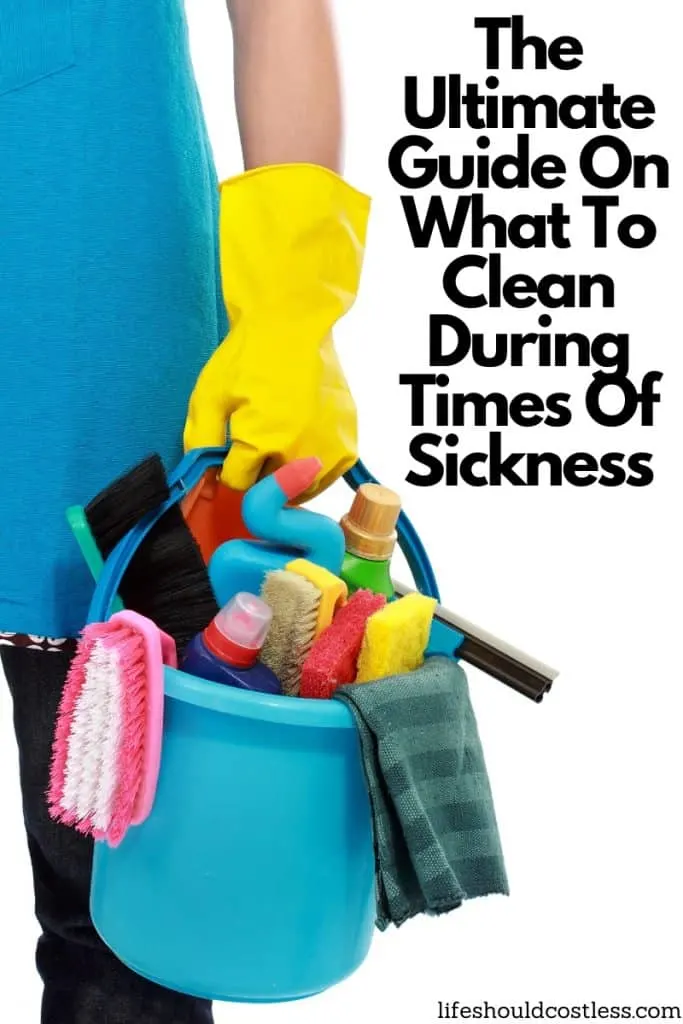
Please keep in mind that my advice is just that, advice from a mommy blogger (although experienced in the school of hard knocks, I am no scholar), so please make sure to do your own research on exactly what germs you’re trying to kill and choose the best method of cleaning that is right for your particular needs and family.
LET’S BEGIN WITH A BRIEF HISTORY LESSON ON MY EXPERIENCE WITH CLEANING
To date, my cleaning tutorials and tips have had millions of page-views so far and been shared by some of the largest websites out there, but my experience with cleaning goes much deeper than that.
To say that I used to be OCD/neurotic about cleaning and disinfecting is a huge understatement.
I mean, I literally used to shampoo the carpets in my whole house every six weeks on schedule…and my daily cleaning checklist was a mile long so that my home was constantly “showing-ready”…which is tough to do when you have several small children.
I know that my cleaning was over the top obsessive, some would even say psycho and my friends would sometimes even tease me about getting out goggles and gloves to tidy up the smallest of messes, but cleaning is how I coped with some pretty terrible things that happened to me, it was what I turned to instead of drugs or some other addiction, because for a very long time I felt like the only thing in my life that I had control over was how clean my house was… and I clung to that notion for dear life.
Over the years since those hard times, I have had to learn how to chill out because I was running myself ragged and it just plain wasn’t fair to my kids to get in trouble for making a tiny mess…you know, for just being kids…but when it come to times of sickness, the old me peeks back through and I sometimes go on a cleaning binge/frenzy because I want the sickness and germs out of the house so that no one gets re-infected, or so that as few people as possible will get it.
Die germs, die!
You know, because there are sick germs all over the house, and in the air, not just in the areas that got throw up on them or were coughed on, so I am going to impart with you my obsessive cleaning advice, I know it’s overwhelming, but just do your best.
I know that some of you will think that this post is extreme and others will think “oh, that is a good idea, why didn’t I think of that”? So it is more than worth it to me to share this for those of you that will appreciate it and put my suggestions into action.
Though, before I start telling you to wipe down this or that with “sanitizing wipes” of some sort, I thought that I would share with you how to work around it if you cannot find any anti-bacterial/sanitizing wipes or spray…or if they’re just plain not an option. Knowing this will give you much better results when you start trying to do the stuff that I’m going to be mentioning below.
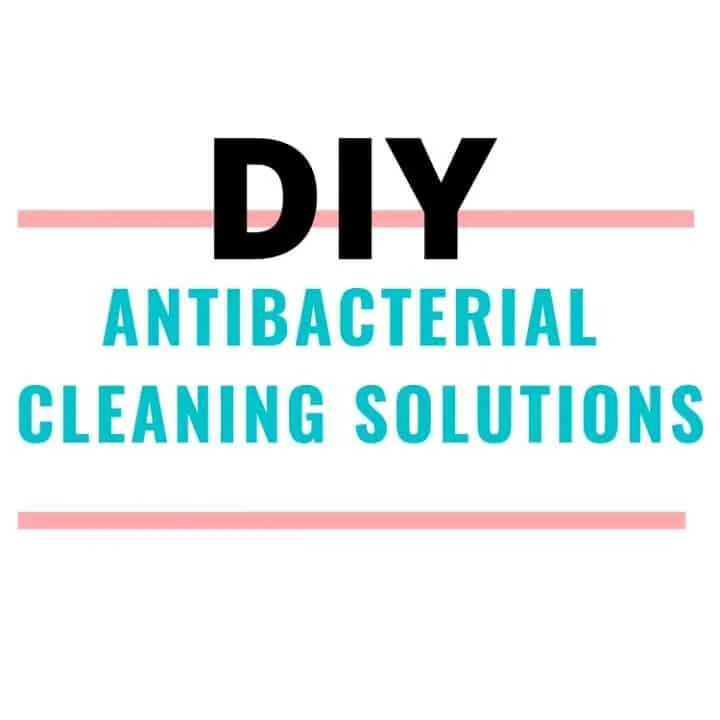
DIY Disinfectant/ Antibacterial Cleaning Solutions
If sanitizing wipes are not readily available, or you are just trying to save money/the environment, there are other options for killing germs.
Tools
- Bucket or Spray Bottle
- Clean Rags Or Paper Towels
- Water
- Lysol Disinfecting Concentrate
- Clorox Bleach
- White Distilled Vinegar
- Rubbing Alcohol
Instructions
How to dilute Lysol Disinfecting Concentrate:
To Disinfect/Deodorize Hard Non-Porous Surfaces: Remove heavy soil first, then add 1.3 oz (2.6 tbsp) to one gallon of water and apply with a sponge or mop, wetting all surfaces thoroughly. Let stand 10 minutes, then wipe away excess. Prepare a fresh bucket of solution every time you clean or more often if necessary. For Hospital Disinfection: Add 4 oz (1/2 cup) to one gallon of water and apply with sponge or mop, wetting surfaces thoroughly. Let stand 10 minutes, then wipe away excess. Prepare a fresh bucket of solution every time you clean or more often if necessary. As per the instructions on the bottle.
How To Dilute Clorox Bleach:
I was actually terribly surprised to learn that there are a great many different types and strengths of Clorox Bleach that require different instructions for dilution. Here is link for a break-down of how to dilute each different type of bleach according to Clorox.com.
How To Dilute Vinegar:
A 50/50 solution of White Vinegar and Water can be used as a natural disinfectant. As sourced by BHG.com.
How To Dilute Rubbing Alcohol for Disinfecting:
As per the CDC, rubbing alcohol should not be diluted more than 50%, but they recommend using it at anywhere from a 60-90% rubbing alcohol to water solution to kill germs. Keep in mind that rubbing alcohol comes pre-diluted and will say right on the bottle what percentage it is diluted to, which is typically 70 or 90%.
If using any of these options in a bucket, wear protective gloves and dip a cleaning rag into the solution. Wring out well, and clean as needed. If necessary, wipe down the item afterwards with a wet (with only water) rag to remove any unwanted chemical residue.
Notes
*When you cannot find, or do not have access to any type of disinfectant, soap and hot water are a good option to do your best to get by.*
These cleaning solutions can be put in a (fresh) spray bottle and sprayed directly onto hard surfaces, then allow the cleaning solution to sit there for 30 seconds or more (giving it time to disinfect) before wiping off, for any soft surfaces I would avoid using bleach, but if you're worried about ruining something, you can spray onto an inconspicuous test area first to ensure that there won't be any problems.
If there is another cleaning product that you have on hand, or prefer, make sure to check out the website for that product and they will give you proper directions on how to use it.
*Make sure to never mix chemicals with each other, and make sure that you are always in a well-ventilated area any time you are using them.*
Here is my full, free printable list, of what I try to focus on to clean the sick germs out of my home.

Checklist: What To Clean In Times Of Sickness
What to clean to in your home to both sanitize before or after sickness, as well as to reduce spreading it to others.
Instructions
High Level Disinfection Checklist:
Whole House:
Wipe down pens/writing utensils, phones, tablets, computers, printers,touch screens, keyboards/buttons, & all electronics(instructions to disinfect electronics are found here).
Wipe down all knobs, handles, light switches, banisters, toy boxes, doors & door frames.
Gather and put in kitchen sink all dirty dishes, pacifiers, bottles, & sippy cups.
Wash the walls, everywhere that would have been touched. If you would like to see how I do this quickly, you can see my most popular post of all time here…it’ll make the task take like 1/4th as much time or less.
Gather all toys and disinfect (you can find instructions here).
Wipe down tables, desks, chairs, and any hard furniture that is frequently touched.
Vacuum then disinfect/wash all flooring starting in the rooms where sickness was the worst. I disinfect my carpet by spritzing it with a 50/50 vinegar to water solutions and allowing it to dry before reusing.
Gather all bedding/linens/towels/dirty laundry (instructions for how to disinfect laundry here).
Vacuum then disinfect couches, mattresses, & upholstered furniture. (instructions found here).
Air out the whole home to let in fresh air so that germs aren't hanging around. It's a good time to swap out your furnace filter too.
Drapes can be sprayed with a non-bleach disinfectant spray.
Nebulizers, CPap Machines, Humidifiers, De-humidifiers, and Air Purifiers need to be maintained and cleaned as well.
Lunch boxes and back packs need to be sanitized.
Any shoes that have been worn within the last week or so need sanitized too.
Kitchen/Dining Area:
Wipe down tables, counter tops, all lower cabinetry & knobs, bars stools, chairs, door knobs, all appliances and their handles. If small children are in the home wipe down anything that is touched by them often.
Throw away all leftover food... you never know if the sickness is just food poisoning, or was transmitted through food consumption so open food containers must go. It's a good time to go through the whole fridge and toss expired items while you're at it too.
Throw away all old sponges. Make sure to swap out hand towels and cleaning rags frequently.
Wash all dirty dishes with a high heat/sanitize setting on your dishwasher. If washing by hand is your only option, here is a good resource to learn how to sanitize your dishes.
Wipe down the trash can and all the hard surface areas around/ behind/under it.
Remind children not to share drinks, food, or anything that touches the mouth or face.
Make sure that drink cups/ water bottles/ hydroflasks are washed and sanitized daily.
Wash soda cans and bottles before drinking directly from them.
Mop and disinfect the floor.
Bathroom:
Wipe down faucets, sinks, counters, cabinetry, knobs, the medicine cabinet, the door to the bathroom both inside and out and include the door frame. Wipe soap dispensers, tooth paste tubes, and hair brushes.
Refill the soap containers and hand sanitizer.
Swap out hand towels daily for a fresh and sanitized towel.
Toothbrushes, combs & hair brushes, and contact lense cases go through the dishwasher on high heat/sanitize, or get thrown away and replaced (depending on the type of sickness, use your best judgement). Each child should have their own individual tooth paste tube to prevent spread of sickness.
All make-up brushes and sponges need to be washed and sanitized.
Scrub down or sanitize the shower or bath tub.
Disinfect the toilet and all flooring and walls within several feet.
Empty, put in a fresh liner, and wipe down the exterior of garbage can.
Disinfect the hamper.
Try to have a separate bathroom to use for the sick individual if at all possible.
Make sure that everyone is washing hands both before and after using the bathroom.
Mop and disinfect the floor.
Notes
Don't forget to disinfect those barf buckets! That’s what we lovingly refer to them at my house… I usually start by rinsing them out really well. Then use warm soapy water to wash, rinse, then spritz it with vinegar or bleach solution, allow to sit for a minute or two and re-rinse. If your dishwasher is large enough you could just rinse and stick it in there. Maybe use a lower heat setting though in case the plastic wasn’t meant to go through a high-heat cycle.
The task of getting sickness out of your home can be completely overwhelming...don't forget to delegate some of the easier tasks to older children that will do a good job.
Check what needs cleaned in the car. Often people get sick in the car and it gets all over the car seats. If this happens I take all the cloth off of the car seat and throw it in the wash and then let it air dry on my drying rack. The rest of the car seat gets scrubbed down in the tub making sure to do so before I scrub down the bath tub. Use disinfectant wipes on anything in the car that may have been touched.
If you have small children it makes it hard to get to everything before they touch everything. I recommend just shutting and locking the doors to the rooms that you need to sanitize, until you can get to it, so that children don't wander in there and get infected.
When you're cleaning, don't work against gravity, make sure to clean from top to bottom, which will give you much less work in the long-run not having to re-do anything.
How To Disinfect Electronics
I have found that the best way to disinfect electronics is to wipe down with disinfecting wipes and allow to dry, or use one of the DIY cleaning solutions, as mentioned above in this post, dip a clean rag into it and wring it out really well, then wipe the entire device clean.
Make sure not to drip anything into the device. If using one of the cleaning solutions in a spray bottle, spray into a clean rag before wiping, NEVER spray directly onto an electronic device, and wipe the entire device down. Allow to air dry well before using again.
How To Disinfect/Sanitize A Couch/Beds/Upholstery
In order to sanitize your soft surfaces, they first need to be fairly clean in general… make sure to vacuum them. Then you spritz them with a disinfectant cleaner of your choice, though I do not suggest using bleach because it will ruin your stuff. You do not need to fully saturate anything, a light misting should suffice. Allow to air dry before using again.
If your soft surfaces got direct body fluid on them, I suggest using my method for cleaning up and sanitizing vomit/poop, that can be found here.
How To Disinfect Toys
The younger your kids are, the more you have to worry about disinfecting their toys because they just aren’t going to understand if you tell them not to touch something or put it in their mouth. There are several kinds of toys that need to be sanitized, so here is a printable break-down to help you to know how to clean the various types of toys.
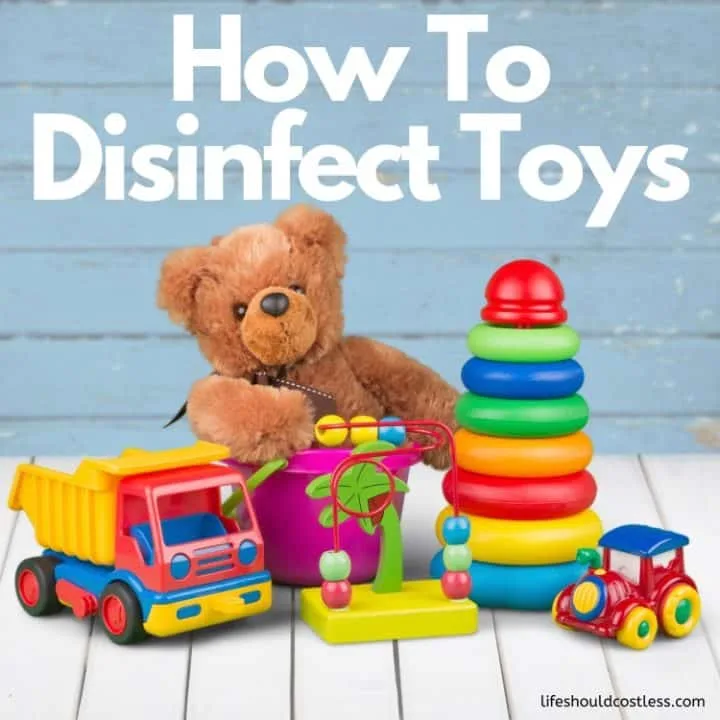
How To Disinfect Toys
How to sanitize and disinfect various types of toys.
Tools
- Clean Rags
- Bucket or (fresh) Spray Bottle
- Clorox Bleach
- White Distilled Vinegar
- Disinfecting Wipes Or DIY Cleaning Solution
- Dishwasher
- Washing Machine And Dryer
- Drying Rack
Instructions
How To Disinfect Toys (hard/non-porous/non-electronic toys):
With Bleach (according to Clorox.com): Mix 1/2 Cup regular Clorox Bleach per gallon of water, let soak for five minutes, or scrub clean while in the solution. Rinse well, let air dry.
With Vinegar: Mix a 50/50 solution of water and white distilled vinegar and allow to soak for five minutes or more. Rinse well, let air dry.
With Your Dishwasher: This is the laziest, and by far my favorite way to do it. Place toys in the top rack of dishwasher and allow to run on high heat or with the "sanitize" setting selected. Only do this to types of plastics and silicones that can handle the heat.
How To Disinfect Plush Toys (non-electronic):
With Your Washing Machine And Dryer: Place toys into washing machine, do not fill above 3/4 capacity, and wash as per my "how to disinfect laundry" instructions below in the post. If toys have bodily fluids on them you may need to run them through a rinse cycle on cold first, and then wash as per the disinfecting guidelines below. If disinfectant isn't an option, use the warmest/hottest water that you can, and the maximum amount of detergent called for on the detergent instructions. Then dry in the dryer on medium to high heat to kill any residual germs. (Washing things in the washing machine may mat the fur, but you can brush it back out). If toys did not get any fluids on them, and you would just like to disinfect them you can sometimes just toss them in the dryer on high for a half hour or so and the heat will kill most germs.
How To Disinfect Electronic Plush Toys:
If these toys did not get any bodily fluids on them. I suggest just spraying them with your choice of disinfecting spray, allow to sit for a couple of minutes, and then use a clean rag, dampened with water, to wipe off as much of the chemical as possible. Allow to air dry. If the toy did get puke or diarrhea on it, I personally would just throw it away, but you can do your best to save it with getting a rag fairly saturated with a sanitizing solution and wiping it down, repeatedly, and then once it's done getting "clean" wipe it down one last time with a rag that was dipped in water to clean off residual chemicals. It's a good idea to remove the batteries before you attempt cleaning an electronic toy, and then allow it to air dry for a day or two before putting the batteries back in for use.
How To Disinfect Electronic Toys:
Wipe down with disinfecting wipes and allow to dry, or use one of the DIY cleaning solutions, as mentioned above in this post, dip a clean rag into it and wring it out really well, then wipe the entire device clean. Make sure not to drip anything into the device. If using one of the cleaning solutions in a spray bottle, spray into a clean rag before wiping, NEVER spray directly onto an electronic device, and wipe the entire device down. Allow to air dry well before using again.
Notes
Some people suggest using a germ fogger to clean toys, and I think that it is an extreme way to clean toys...plus, there will be chemical residue all over the toys which will end up in the child's mouth, so I do not recommend that method for sanitizing toys.
Wood toys should never get submerged in water. Use the same method that I suggest for cleaning electronic toys.
How To Disinfect Laundry
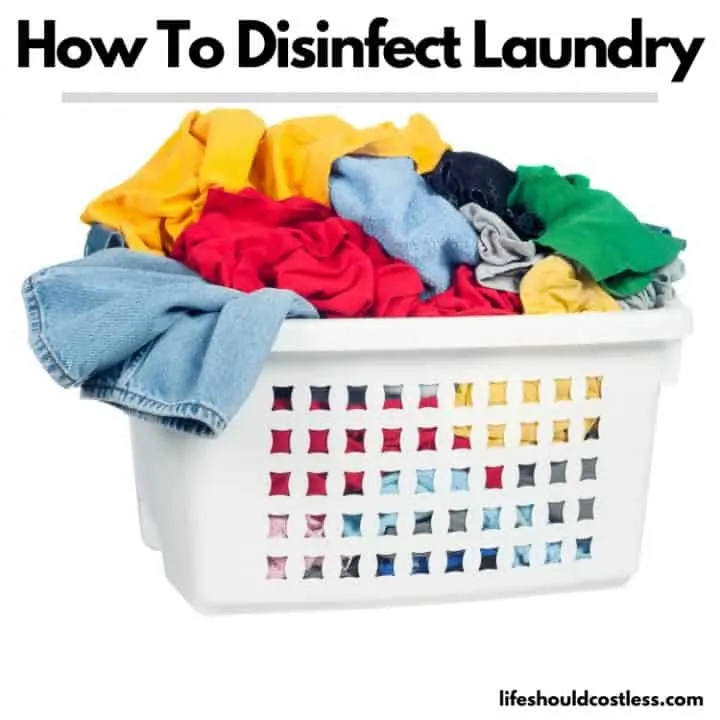
How To Disinfect/Sanitize Laundry
Knowing how to kill germs when doing laundry is half the battle in times of sickness. Here is how to sanitize or disinfect laundry with bleach, without bleach, with vinegar, with Lysol laundry sanitizer, and in cold water.
Tools
- Clorox Bleach
- Lysol Laundry Sanitizer
- White Vinegar
- Downy Ball Automatic Dispenser
Instructions
How To Sanitize Laundry With Clorox Bleach:
According to Clorox.com: You should use 3/4 cup of bleach for a regular size load with an average soil level, and 1 ¼ cup for an extra-large or heavily soiled load. Using less than the recommended amount will not provide the correct amount of bleach active to disinfect the load. For use in HE machines, use 1/2 Cup Clorox.
How To Disinfect Laundry With Lysol Laundry Sanitizer (in any temperature of water):
According to Lysol.com: For standard machines, Fill 2 capfuls to line 1 of the dosing cup. For HE machines, Fill 2 capfuls to line 2 of the dosing cup. Add two capfuls to the fabric softener compartment at the start of laundry cycle.
If machine does not have a fabric softener dispenser, wait until rinse cycle and add directly to drum of machine. Leave in rinse cycle for 16 minutes. Clothes come out sanitized killing 99.9%* of bacteria.
How To Disinfect Laundry With Vinegar (at any temperature, cold or hot, a natural laundry disinfectant):
Add 1/2 to 1 cup of White Distilled Vinegar to laundry as the rinse cycle starts to begin. Continue to wash as normal. Repeat, or use more Vinegar if any smells linger.
Notes
Whenever something says to add during the rinse cycle, you can just add whatever disinfectant to a Downy Ball and it will release the disinfectant in the rinse cycle...I always forget to pay attention and miss the rinse cycle, so this is a handy little life hack to get around it.
If you don't have the option of using any cleaning product other than basic detergent make sure to wash and dry in the warmest/hottest heat setting possible that is recommended for the item that you are washing to kill as many germs as you can with what you've got.
Once you have washed the clothes to disninfect, if you are not a fan of the chemical smell that your fabrics now have, you can then rewash them as you normally would or perhaps just run them on an additional rinse cycle.
Make sure not to pack your loads too tightly, you'll get best results never filling your washer more than 3/4 of the way full.
Any loads of laundry that are heavily soiled whether it be puke or poop or blood, make sure to run at least one rinse cycle in cold water before you attempt to sanitize any laundry items.
Have you ever washed something after someone has gotten sickness on it (poop, vomit, urine, or a combination of those things) and it still smelled gross afterwards? That is because there is still some bacteria living in it that needs to be killed.
I wanted to share how to sanitize or disinfect laundry with bleach, without bleach, with vinegar, with Lysol laundry sanitizer, and in cold water because there are just so many ways to do it. Here is a free printable “How-To” card so that you can have this info handy at all times.
I like to sanitize my towels and the whole families bedding about once a month on a normal basis, regardless of sickness going around, just to keep up with the ever-growing bacteria that we get on things naturally.
How To Clean Up and Disinfect Puke/Vomit/Diarrhea
There are several methods to tackle this nasty task, but I am just going to share with you how I do it this will also teach you how to get the vomit smell out of carpet.
Basically, you need to gather all the chunks with a rag and put them in a garbage can…wear gloves if you’re super grossed out (don’t forget to tie this garbage off and take it out when you’re done). Next we work on soaking up the wet parts with a fresh rag or towel. Once that is completed it’s time to sanitize.
If the vomit is in the carpet, or on a mattress, or couch I generally pour a disinfecting cleaning solution/product (don’t use bleach for carpet, couches, or mattresses or you will ruin whatever you’re cleaning) into the affected area of your soft surface, so the area is completely saturated, allow it to sit for a couple of minutes, and then take a fresh towel and scrub as it is soaking up the excess of the disinfecting solution/product.
You can repeat as needed and I sometimes like to follow this up with pouring warm water into the area and then using a fresh towel to scrub and soak it up one more time. This will remove some of the residual chemicals. Wash all of the rags and towels as directed above in the How To Disinfect Laundry section.
I think I touched base on most everything that I do and explained everything to the best of my current ability.
I know it seems like a lot, but you can give the easier tasks to your healthy kids/spouse that doesn’t like cleaning and just make sure they wash their hands well when done if using anything “chemical-y”(I’m talking about the kids here…can you imagine the look on your spouse’s face if you told them to wash up afterward, ha ha).
Frankly, I usually decide which things need to happen first, do those, and then just get to the others as quickly as I can while trying not to stress about it too much.
If you liked this post, make sure to check out my entire cleaning section, I have been writing since 2011 so there is so much to learn.
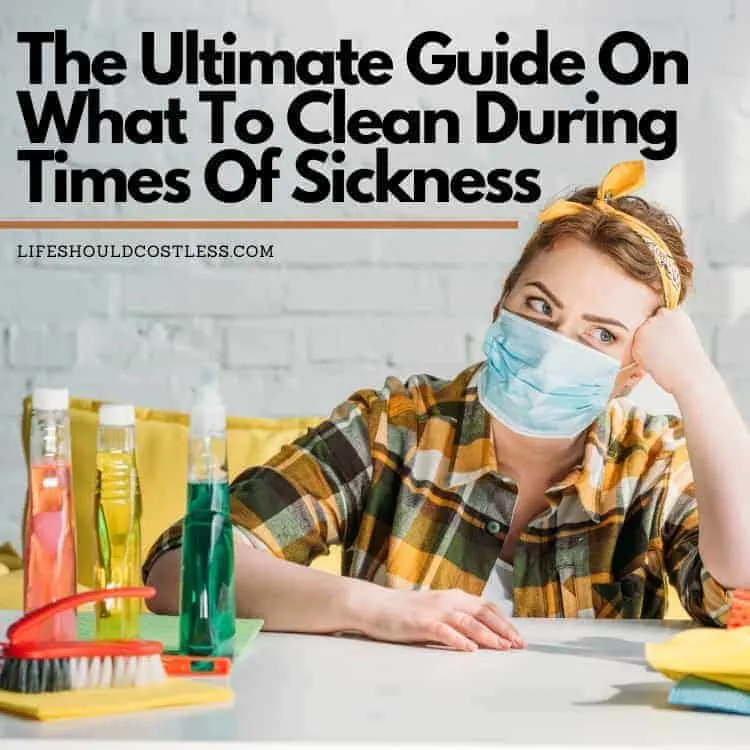
As usual, please share this post with anyone that may find it useful…whether it be via social media, or sending them a direct link via email, I appreciate it. Thanks so much!~Sarah
How To Follow & Support This Site
- If you would like to subscribe to my email list, go here.
- Make sure to follow along via social media, by going here.
- If you would like to learn how to really show your support to this site (at no cost to you), go here.
- If you would like to make a direct donation to the site, go here.
Here are links to several of my other posts that you’re also going to love:
For those of you that would like more options of a “Pinnable image” for Pinterest, here you go. Thank you so much for the support!

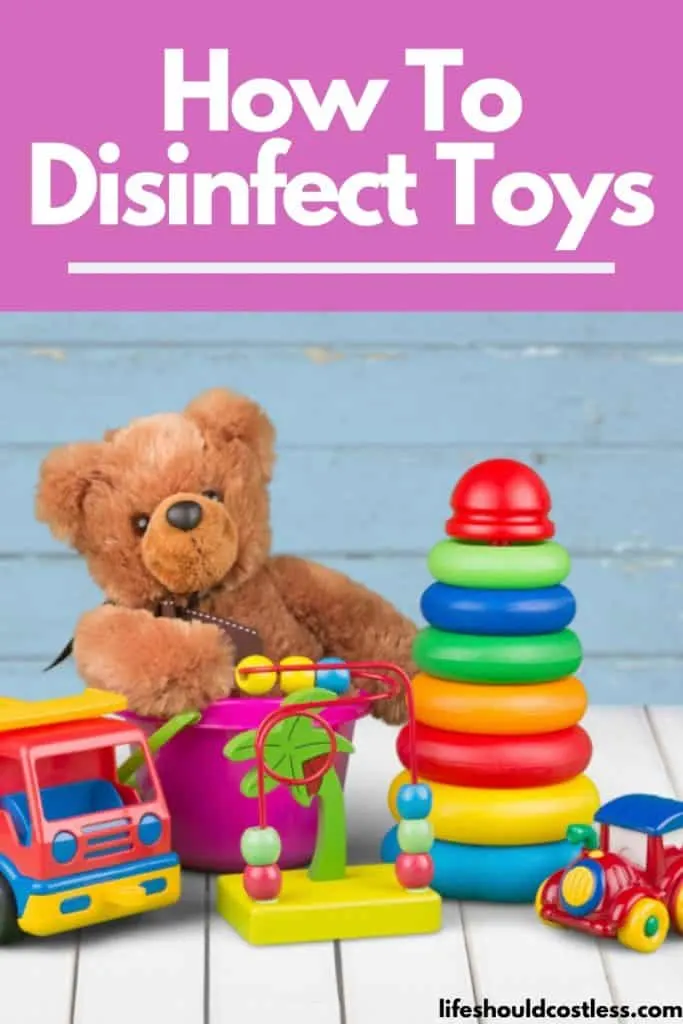

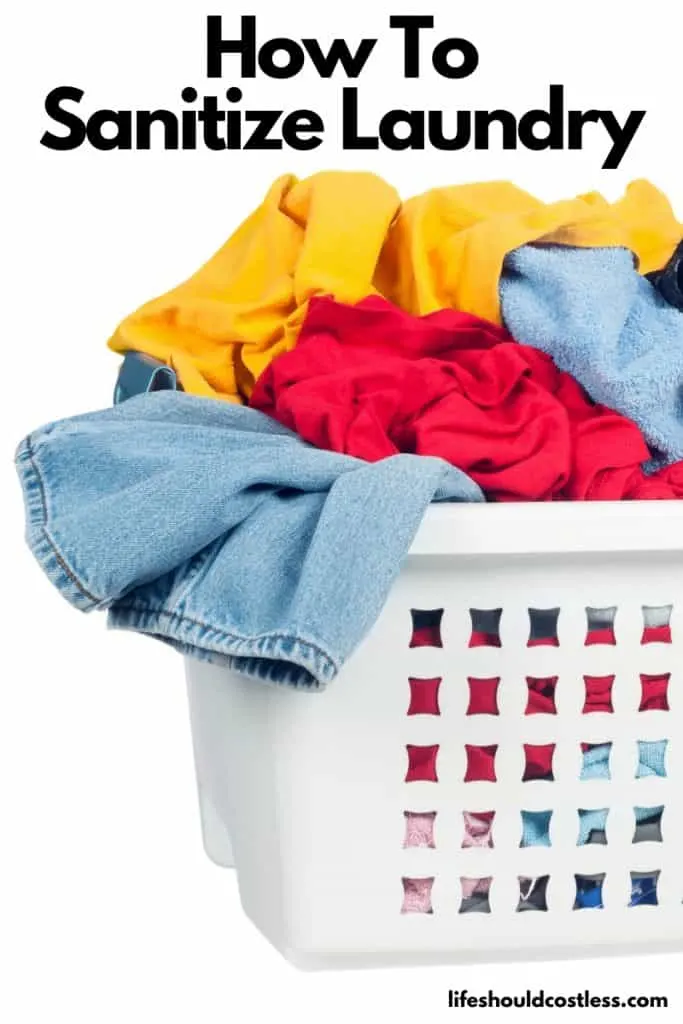
*Please note: This content was originally published to this website on April 26, 2016. It has since been updated to include more thorough information, as well as a free printable cleaning checklists and “how-to” cards.
